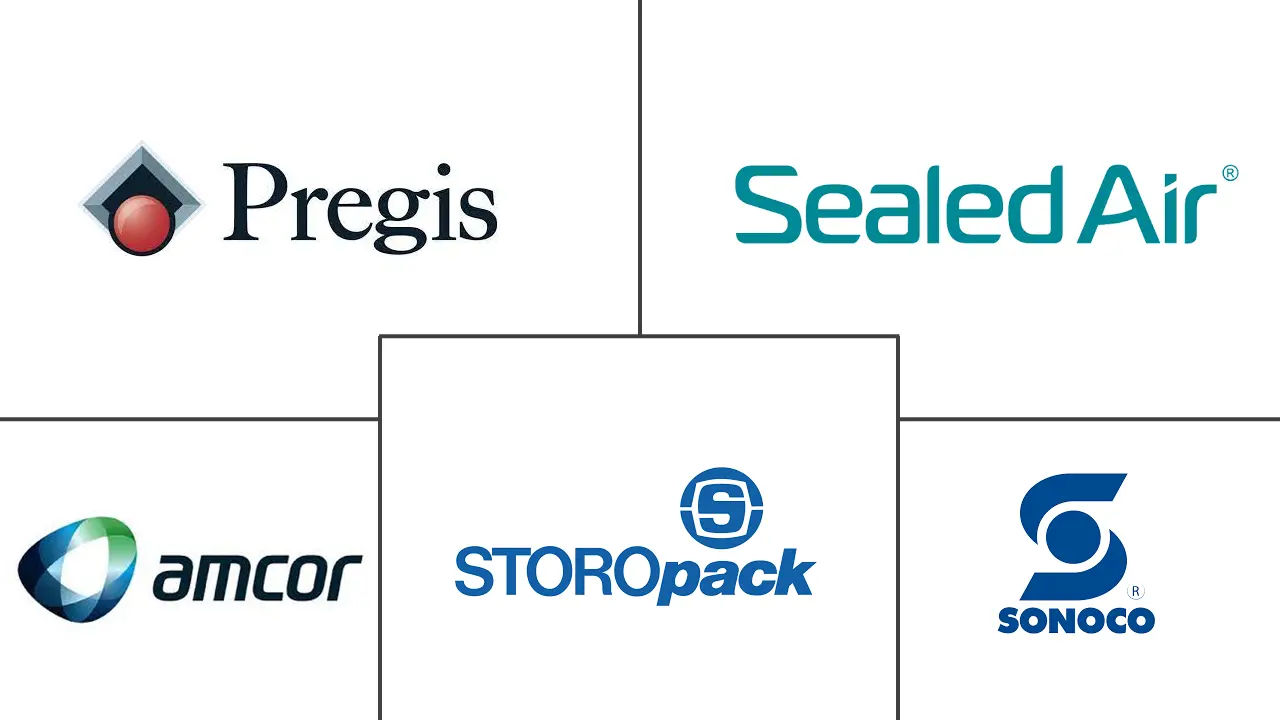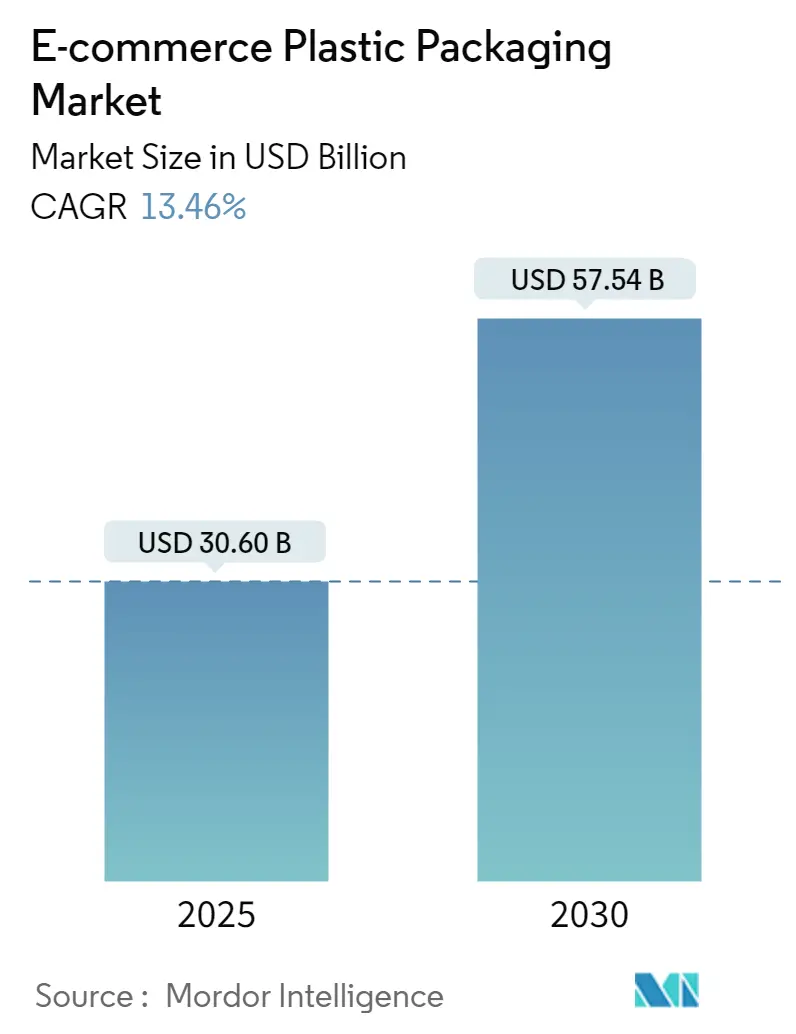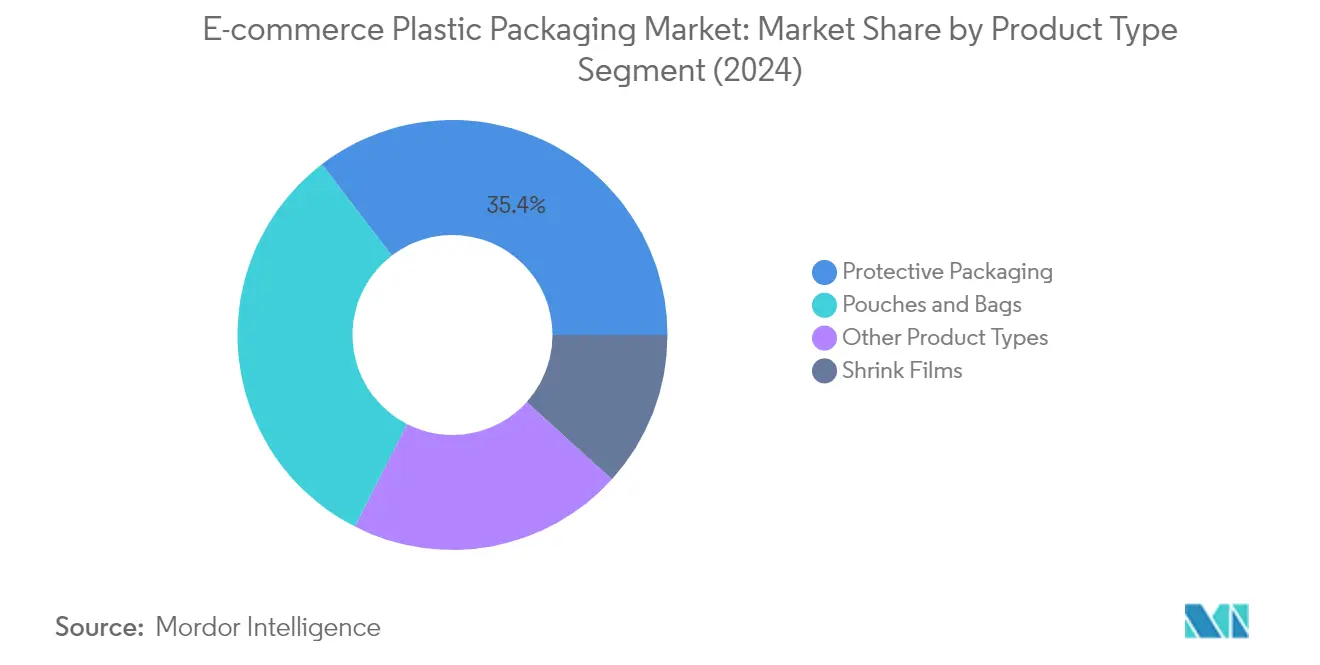E-commerce Plastic Packaging Market Analysis
The E-commerce Plastic Packaging Market size is worth USD 30.60 Billion in 2025, growing at an 13.46% CAGR and is forecast to hit USD 57.54 Billion by 2030.
The e-commerce packaging landscape is experiencing significant transformation driven by evolving consumer behaviors and technological advancements. China currently generates approximately 50% of the world's e-commerce transactions, with major platforms like Alibaba's Taobao Tmall and JD.com dominating the market. The rise of direct-to-consumer (D2C) business models is reshaping packaging requirements, with the Indian D2C market alone projected to reach USD 60 billion by FY27. This shift has prompted packaging manufacturers to develop specialized e-commerce packaging solutions that balance protection, sustainability, and cost-effectiveness.
The industry is witnessing a strong push toward sustainable packaging solutions, with major retailers leading the transformation. In March 2023, Amazon's Climate Pledge Fund announced an investment in Genecis, a bioplastics company that creates biodegradable PHA from organic waste. This innovation represents a significant step toward replacing traditional plastic products with fully biodegradable options. The trend is further exemplified by Flipkart's launch of a dedicated e-store for sustainable products in January 2023, demonstrating the growing emphasis on eco-friendly e-commerce packaging solutions.
Technology integration is becoming increasingly crucial in the packaging sector, particularly for consumer electronics protection. According to Ericsson, smartphone subscriptions are expected to exceed 7.7 billion by 2028, driving demand for specialized protective e-commerce packaging solutions. Manufacturers are developing innovative protective materials such as air bubble wraps, air pillows, and other inflatable packaging products specifically designed for electronic devices. These solutions not only provide superior protection but also optimize shipping costs through reduced weight and improved space efficiency.
The industry is experiencing significant consolidation and expansion through strategic acquisitions and partnerships. In August 2023, Amcor acquired Phoenix Flexibles to strengthen its presence in the rapidly growing Indian market, highlighting the industry's focus on emerging markets. Companies are increasingly investing in research and development to create mono-polymer flexible packaging laminates that ensure circularity while maintaining the benefits of flexible packaging. This trend is particularly evident in the food and beverage sector, where packaging must balance protection, preservation, and sustainability requirements.
E-commerce Plastic Packaging Market Trends
Growing Proliferation of Online Retailing and Emergence of Omni-Channel Presence
The transition of retail toward online channels has fundamentally transformed packaging requirements and solutions. According to the Census Bureau of the Department of Commerce, e-commerce sales in the United States reached USD 277.6 billion in the second quarter of 2023, representing a 2.1% increase from the first quarter. This continuous growth in online retail has necessitated more robust and specialized online shopping packaging solutions to protect products through multiple handling points in the supply chain.
The emergence of omnichannel retail has created new demands for versatile packaging solutions that can serve both online and offline channels effectively. Retailers are implementing omnichannel distribution strategies for their products, including online purchases, which require packaging that maintains brand identity while ensuring product protection across various distribution channels. This trend has led to innovations in packaging design that can withstand the rigors of e-commerce shipping while maintaining visual appeal for both online and in-store presentations.
Rising Usage of Lightweight Flexible Packaging
Flexible packaging has become increasingly prevalent in e-commerce due to its significant advantages in weight reduction and space efficiency. The Flexible Packaging Association indicates that developments in production processes and material innovation have decreased the weight of some flexible packaging by approximately 50%. This reduction in weight directly translates to lower shipping costs and a reduced carbon footprint during transportation.
The adoption of flexible formats is particularly beneficial for e-commerce operations as they generally result in reduced dimensional weight. Since billable weight is determined by whichever value is greater—dimensional or actual weight—shipping costs can be significantly lower for space-efficient packages. Additionally, much of the flexible packaging used for e-commerce shipping is made of reusable and recyclable polyethylene, allowing for multiple uses and supporting sustainability initiatives.
Increasing Biodegradable Plastic Packaging for Online Retail
The market is witnessing a significant shift toward biodegradable plastic packaging solutions as environmental concerns drive innovation in sustainable materials. Unlike traditional plastics, biodegradable plastics are obtained from renewable sources, with first-generation bioplastics derived from sugars or starches such as wheat, corn, sugarcane, or soy, while second-generation bioplastics utilize cellulose from industrial processes or crops.
The trend toward biodegradable packaging is supported by substantial industry investments and technological advancements. For instance, in May 2023, Polymateria announced plans to raise GBP 20 million to expand biodegradable plastic technology at Imperial's White City Campus. The technology enables manufacturers to manage the lifespan of their plastic products while ensuring recyclability, representing a significant step forward in addressing the environmental impact of e-commerce packaging. This development is particularly important as countries worldwide implement stricter regulations on single-use plastics and push for more sustainable packaging solutions.
Segment Analysis: By Product Type
Protective Packaging Segment in E-commerce Plastic Packaging Market
The Protective Packaging segment dominates the global e-commerce plastic packaging market, holding approximately 35% market share in 2024. This segment includes air pillows, bubble packaging, spacers, and other protective materials designed to shield goods from atmospheric, magnetic, vibration, or shock damage during transit. The segment's prominence is driven by the increasing need for protection during transportation, particularly in the consumer electronics industry where products are highly fragile and require careful handling. Protective packaging has become essential for e-commerce businesses due to the increased number of touchpoints during transportation. The trend toward customized protective packaging further strengthens this segment's position, as manufacturers develop innovative, eco-friendly materials that provide optimal protection during transportation while enhancing brand image and customer satisfaction.
Pouches and Bags Segment in E-commerce Plastic Packaging Market
The Pouches and Bags segment is experiencing the fastest growth in the e-commerce plastic packaging market, with a projected growth rate of approximately 14% from 2024 to 2029. This remarkable growth is attributed to the segment's versatility and cost-effectiveness in various applications. The segment's expansion is driven by innovations in sustainable solutions, with manufacturers developing new eco-friendly alternatives and incorporating recycled content in their products. The growth is further supported by the increasing adoption of plastic pouches and bags across multiple industries, including personal care, food and beverage, and healthcare. These packaging solutions are particularly favored for their lightweight properties, decreased transportation costs, and lower carbon footprint compared to traditional packaging alternatives.
Remaining Segments in E-commerce Plastic Packaging Market
The remaining segments in the market include Shrink Films and Other Product Types, which together play a vital role in the e-commerce packaging ecosystem. Shrink films are particularly important for bundling and protecting products during transit, offering excellent visibility while maintaining product integrity. The Other Product Types segment, which includes labels, tapes, and various specialized packaging solutions, contributes significantly to the market by providing essential complementary packaging materials. These segments continue to evolve with technological advancements and increasing demand for sustainable solutions, adapting to changing consumer preferences and environmental regulations while maintaining their crucial role in the e-commerce supply chain.
Segment Analysis: By End-User Industry
Consumer Electronics and Media Segment in E-commerce Plastic Packaging Market
The Consumer Electronics and Media segment dominates the global e-commerce plastic packaging market, holding approximately 26% market share in 2024. This significant market position is driven by the increasing demand for protective packaging solutions for fragile electronic devices and media products. The segment's prominence is supported by the growing adoption of smartphones, tablets, laptops, and other electronic devices purchased through online channels. Manufacturers of packaging products for consumer electronics are increasingly utilizing protective packaging items such as air bubble wraps, air pillows, and other inflated packaging products to shield devices during transit. The rise in cross-border e-commerce and the need for enhanced product protection during long-distance shipping have further strengthened this segment's market position. Additionally, the segment benefits from the continuous innovation in packaging solutions that offer superior protection while maintaining cost-effectiveness and sustainability.
Food and Beverage Segment in E-commerce Plastic Packaging Market
The Food and Beverage segment is emerging as the fastest-growing segment in the e-commerce plastic packaging market, with a projected growth rate of approximately 14% from 2024 to 2029. This remarkable growth is primarily driven by the increasing consumer preference for online grocery shopping and food delivery services. The segment's growth is further accelerated by innovations in modified environment packaging that maintains food freshness by enclosing a low-oxygen air mixture in plastic packages. The rising demand for sustainable and recyclable packaging solutions in the food sector has led to significant developments in eco-friendly plastic materials. The segment is witnessing substantial investments in smart packaging technologies that can monitor food freshness and maintain proper temperature during transit. Additionally, the expansion of quick commerce and the growing trend of ready-to-eat meals have created new opportunities for specialized plastic packaging solutions that ensure food safety and quality during delivery.
Remaining Segments in E-commerce Plastic Packaging Market
The remaining segments, including Personal Care Products, Fashion and Apparel, and Home Care and Furnishing, each play vital roles in shaping the e-commerce plastic packaging market landscape. The Personal Care Products segment emphasizes barrier properties and easy transportation features in its packaging solutions, while the Fashion and Apparel segment focuses on lightweight, water-resistant e-commerce fashion packaging materials that protect clothing items during transit. The Home Care and Furnishing segment utilizes various plastic packaging solutions for protecting furniture and home care items from damage during shipping. These segments are witnessing significant transformations driven by sustainability initiatives, with many companies shifting towards recyclable and biodegradable packaging materials. The integration of smart packaging features and the adoption of omnichannel distribution strategies are further influencing the development of specialized packaging solutions across these segments.
E-commerce Plastic Packaging Market Geography Segment Analysis
E-commerce Plastic Packaging Market in North America
The North American e-commerce packaging market demonstrates robust growth driven by advanced e-commerce infrastructure and high internet penetration rates. The United States and Canada represent the key markets in this region, with both countries showing strong adoption of online shopping platforms. The region benefits from well-established logistics networks, innovative packaging solutions, and increasing consumer preference for convenient shopping experiences. The market is characterized by significant investments in sustainable packaging solutions and technological advancements in protective packaging materials.
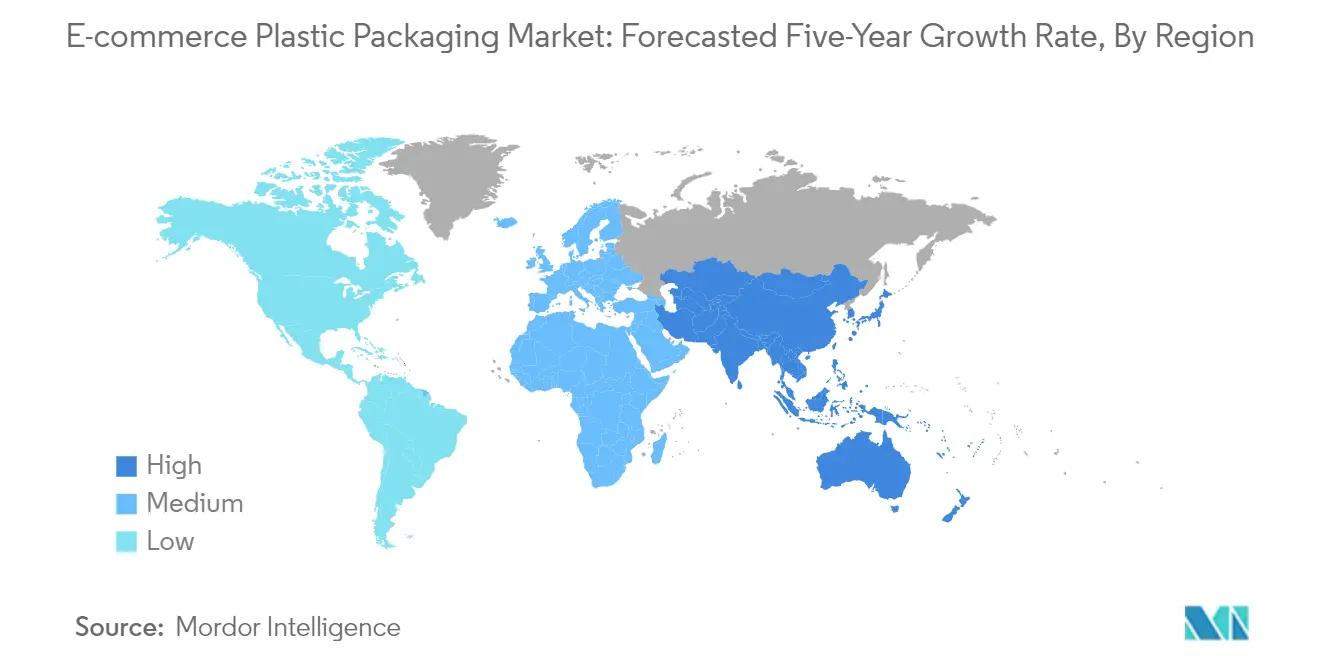
E-commerce Plastic Packaging Market in United States
The United States leads the North American market with approximately 82% e-commerce plastic packaging market share in 2024, establishing itself as the dominant force in the region. The country's e-commerce packaging sector is driven by major players like Amazon and Walmart, who are continuously innovating their packaging solutions. The market shows strong growth in protective packaging segments, particularly for electronics and consumer goods. American consumers increasingly demand sustainable packaging options, prompting manufacturers to develop eco-friendly alternatives. The implementation of advanced packaging technologies and automation in fulfillment centers further strengthens the market position.
E-commerce Plastic Packaging Market in Canada
Canada emerges as the fastest-growing market in North America, with a projected growth rate of approximately 14% from 2024 to 2029. The country's e-commerce plastic packaging sector benefits from increasing internet penetration and growing consumer confidence in online shopping. Canadian retailers are actively adopting omnichannel strategies, driving demand for various packaging solutions. The market shows particular strength in protective packaging for electronics and personal care products. Government initiatives supporting sustainable packaging solutions and improving recycling infrastructure contribute to market development.
E-commerce Plastic Packaging Market in Europe
The European e-commerce packaging market showcases significant diversity across its key markets, including the United Kingdom, Germany, France, and Spain. The region demonstrates a strong commitment to sustainable packaging solutions and circular economy principles. European countries are implementing stringent regulations regarding plastic usage, driving innovation in recyclable and biodegradable packaging materials. The market benefits from advanced logistics infrastructure and growing cross-border e-commerce activities.
E-commerce Plastic Packaging Market in United Kingdom
The United Kingdom maintains its position as the largest market in Europe, commanding approximately 31% e-commerce plastic packaging market share in 2024. The country's e-commerce packaging sector is characterized by high adoption rates of online shopping across various product categories. British retailers are increasingly focusing on sustainable packaging solutions while maintaining product protection during transit. The market shows particular strength in food and beverage packaging, consumer electronics, and fashion retail sectors. The UK's advanced digital infrastructure and mature e-commerce ecosystem continue to drive market growth.
E-commerce Plastic Packaging Market in France
France emerges as the fastest-growing market in Europe, with a projected growth rate of approximately 13% from 2024 to 2029. The French market demonstrates strong innovation in sustainable packaging solutions and circular economy initiatives. The country's e-commerce packaging sector is driven by increasing consumer preference for online shopping and growing demand for protective packaging solutions. French retailers are actively adopting eco-friendly packaging alternatives while maintaining product protection standards. The market shows particular strength in luxury goods packaging and food delivery sectors.
E-commerce Plastic Packaging Market in Asia-Pacific
The Asia-Pacific region represents a dynamic market for e-commerce plastic packaging, encompassing diverse economies including China, India, and Japan. The region demonstrates rapid adoption of digital commerce platforms and innovative packaging solutions. Market growth is driven by increasing internet penetration, rising disposable incomes, and expanding middle-class populations across major economies. The region shows particular strength in developing cost-effective and innovative packaging solutions.
E-commerce Plastic Packaging Market in China
China maintains its position as the largest market in the Asia-Pacific region, driven by its massive e-commerce ecosystem and advanced digital payment infrastructure. The country's packaging sector benefits from robust manufacturing capabilities and innovative technological solutions. Chinese e-commerce giants are actively investing in sustainable packaging solutions while maintaining efficiency in their logistics operations. The market shows particular strength in protective packaging for electronics and consumer goods sectors.
E-commerce Plastic Packaging Market in India
India emerges as the fastest-growing market in the Asia-Pacific region, driven by rapid digitalization and increasing e-commerce adoption. The Indian market demonstrates strong growth potential in protective packaging solutions for various product categories. The country's e-commerce packaging sector benefits from government initiatives promoting digital commerce and sustainable packaging solutions. The market shows particular strength in developing cost-effective packaging solutions for diverse product categories.
E-commerce Plastic Packaging Market in Latin America
The Latin American retail e-commerce packaging market shows promising growth potential, with Brazil and Mexico emerging as key markets in the region. The market is characterized by increasing internet penetration rates and growing adoption of digital payment solutions. Brazil emerges as the largest market, while Mexico shows the fastest growth rate in the region. The market demonstrates particular strength in developing cost-effective packaging solutions while adapting to sustainable packaging trends.
E-commerce Plastic Packaging Market in Middle East & Africa
The Middle East & African e-commerce plastic packaging market demonstrates significant growth potential, driven by increasing digital adoption and improving logistics infrastructure. The region shows particular strength in developing market-specific packaging solutions while adapting to global sustainability trends. The market benefits from growing investments in e-commerce infrastructure and increasing internet penetration rates across major economies. The region demonstrates strong potential in protective packaging solutions for various product categories.
E-commerce Plastic Packaging Market Overview
Top Companies in E-commerce Plastic Packaging Market
The e-commerce plastic packaging industry features prominent players like Amcor, Sealed Air, Berry Global, Pregis, Sonoco, and Huhtamaki leading innovation and market development. These companies are heavily investing in sustainable packaging solutions, including recyclable materials and mono-polymer flexible packaging laminates, to align with growing environmental concerns. Strategic partnerships with e-commerce giants like Amazon through programs such as APASS (Amazon Packaging Support and Supplier Network) have become crucial for market positioning. Companies are expanding their manufacturing footprint across emerging markets while simultaneously developing automated and digitally integrated e-commerce packaging solutions. The focus on research and development has intensified, with companies establishing dedicated innovation centers and university partnerships to develop next-generation packaging solutions that balance protection, sustainability, and cost-effectiveness.
Consolidation and Strategic Growth Drive Market
The e-commerce plastic packaging industry exhibits a moderately consolidated structure with a mix of global conglomerates and specialized regional players. Global leaders leverage their extensive manufacturing networks, technological capabilities, and established relationships with major e-commerce platforms to maintain market dominance. These companies typically operate through multiple business segments, offering comprehensive e-commerce packaging solutions across various end-user industries. The market has witnessed significant merger and acquisition activity, with larger players acquiring regional specialists to expand geographical presence and enhance technological capabilities, particularly in areas like sustainable packaging and smart packaging solutions.
The competitive dynamics are characterized by intense rivalry in terms of innovation, pricing, and service quality. Regional players maintain competitive positions through specialized product offerings and strong local customer relationships, particularly in emerging markets. The industry has seen increased collaboration between packaging manufacturers and technology providers to develop integrated solutions that address the evolving needs of e-commerce fulfillment centers. Companies are also forming strategic alliances with raw material suppliers to ensure stable supply chains and maintain cost competitiveness in an increasingly price-sensitive market.
Innovation and Sustainability Define Future Success
Success in the e-commerce plastic packaging market increasingly depends on companies' ability to balance sustainability requirements with performance and cost considerations. Market leaders are investing in circular economy initiatives, developing recycling infrastructure, and creating closed-loop packaging systems. The ability to provide customized solutions for different product categories while maintaining operational efficiency has become crucial. Companies are also focusing on developing smart packaging solutions that integrate with e-commerce platforms' logistics systems, providing real-time tracking and enhanced security features.
Market contenders can gain ground by focusing on niche applications and developing innovative solutions for specific end-user segments. The increasing regulatory pressure on single-use plastics and sustainability requirements presents both challenges and opportunities for market players. Success factors include the ability to quickly adapt to changing e-commerce fulfillment models, maintain cost competitiveness through operational excellence, and develop strong relationships with both e-commerce platforms and end-users. Companies must also consider the growing influence of consumer preferences for sustainable packaging while managing the risk of substitution from alternative materials like paper-based packaging. Additionally, the emphasis on plastic packaging in sales highlights the need for innovative approaches to meet consumer demand.
E-commerce Plastic Packaging Market Leaders
-
Amcor Group GmbH
-
Pregis LLC
-
Sealed Air Corporation
-
Sonoco Products Company
-
Storopack Hans Reichenecker GmbH
- *Disclaimer: Major Players sorted in no particular order
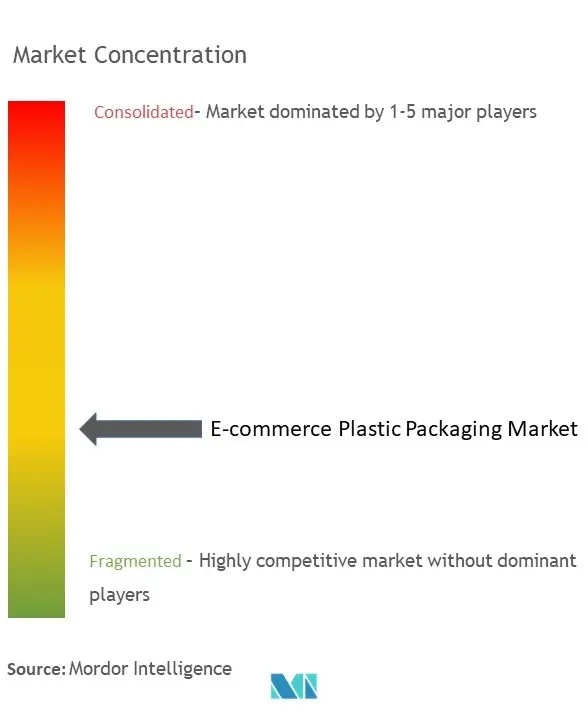
E-commerce Plastic Packaging Market News
- September 2023: Berry Global Group Inc. unveiled a significant development by entering into a five-year power purchase agreement (PPA) with the renowned multinational renewable energy leader ACCIONA Energía. This strategic partnership will drive all four of Berry's facilities in Mexico toward sustainability, harnessing the power of wind and solar energy. Projected to secure nearly 100,000 megawatt hours (MWh) of cost-effective, renewable energy annually, this initiative is expected to contribute significantly to mitigating carbon emissions. It is anticipated to reduce around 40,000 metric tons of annual carbon dioxide equivalent (CO2), aligning Berry with its climate objectives while also offering lower-carbon solutions to empower Berry's customers in its sustainability endeavors.
- August 2023: Amcor decided to acquire Phoenix Flexibles, bolstering its presence in the rapidly expanding Indian market. Phoenix Flexibles, located in Gujarat, specializes in providing flexible packaging solutions for a wide range of consumer products, including food, home care, and personal care items. This strategic acquisition comes as Amcor aims to solidify its foothold in India, adding to its existing portfolio of four flexible packaging facilities in the region.
E-commerce Plastic Packaging Market Report - Table of Contents
1. INTRODUCTION
- 1.1 Study Assumptions and Market Definition
- 1.2 Scope of the Study
2. RESEARCH METHODOLOGY
3. EXECUTIVE SUMMARY
4. MARKET INSIGHTS
- 4.1 Market Overview
-
4.2 Industry Attractiveness - Porter's Five Forces Analysis
- 4.2.1 Bargaining Power of Suppliers
- 4.2.2 Bargaining Power of Buyers/Consumers
- 4.2.3 Threat of New Entrants
- 4.2.4 Threat of Substitutes
- 4.2.5 Intensity of Competitive Rivalry
- 4.3 Industry Value Chain Analysis
5. MARKET DYNAMICS
-
5.1 Market Drivers
- 5.1.1 Growing Proliferation of Online Retailing and Emergence of Omni-channel Presence
- 5.1.2 Rising Usage of Lightweight Flexible Packaging
- 5.1.3 Increasing Biodegradable Plastic Packaging for Online Retail
-
5.2 Market Challenges
- 5.2.1 Lack of Exposure to Good Manufacturing Practices
- 5.2.2 Regulation Pertaining to the Use of Plastic
- 5.2.3 Approach Toward Sustainable Packaging in E-commerce
- 5.3 Post-COVID-19 Impact on the E-commerce Plastic Packaging Industry
6. MARKET SEGMENTATION
-
6.1 By Product Type
- 6.1.1 Pouches and Bags
- 6.1.2 Protective Packaging
- 6.1.3 Shrink Films
- 6.1.4 Other Product Types
-
6.2 By End-user Industry
- 6.2.1 Consumer Electronics and Media
- 6.2.2 Food and Beverage
- 6.2.3 Personal Care Products
- 6.2.4 Fashion and Apparel
- 6.2.5 Home Care and Furnishing
- 6.2.6 Other End-user Industries
-
6.3 By Geography***
- 6.3.1 North America
- 6.3.1.1 Canada
- 6.3.2 Europe
- 6.3.2.1 United Kingdom
- 6.3.2.2 Germany
- 6.3.2.3 France
- 6.3.2.4 Spain
- 6.3.3 Asia
- 6.3.3.1 China
- 6.3.3.2 India
- 6.3.3.3 Japan
- 6.3.3.4 Australia and New Zealand
- 6.3.4 Latin America
- 6.3.4.1 Brazil
- 6.3.4.2 Mexico
- 6.3.4.3 America
- 6.3.5 Middle East and Africa
7. COMPETITIVE LANDSCAPE
-
7.1 Company Profiles*
- 7.1.1 Amcor Group Gmbh
- 7.1.2 Pregis LLC
- 7.1.3 Sealed Air Corporation
- 7.1.4 Sonoco Products Company
- 7.1.5 Storopack Hans Reichenecker Gmbh
- 7.1.6 Berry Global Group Inc.
- 7.1.7 Huhtamaki OYJ
- 7.1.8 CCL Industries Inc.
- 7.1.9 Clondalkin Group
- 7.1.10 Proampac LLC
8. AMAZON E-COMMERCE CONTRIBUTION
- 8.1 Amazon Contribution (%) to E-commerce Sales In the United States (Value)
- 8.2 List of Various Packaging Products Used by Amazon
- 8.3 Suppliers of Packaging Products
- 8.4 Sustainable Packaging Initiatives across Various Countries
- 8.5 Impact of Frustration-free Packaging on Amazon and their Average Savings
- 8.6 Recycling Trends of Plastic Packaging Material (Percentage of Plastic Bags, Sacks, and Wraps Recycled)
9. FUTURE OF THE MARKET
E-commerce Plastic Packaging Market Industry Segmentation
The plastic packaging used by e-commerce companies accounts for a significant part of the packaging material. For products which are light and not fragile, such as clothes, it is ideal.
The e-commerce plastic packaging market is segmented by product type (pouches & bags, protective packaging, shrink films, and other product types), end-user industry (consumer electronics & media, food & beverage, personal care products, fashion & apparel, home care & furnishing, and other end-user industries), and geography (North America (United States, Canada), Europe (United Kingdom, Germany, France, Spain, and Rest of Europe), Asia-Pacific (China, Japan, India, and Rest of Asia Pacific), Latin America (Brazil, Mexico, and Rest of Latin America), and the Middle East and Africa). The report offers market forecasts and size in volume (tons) and value (USD) for all the above segments.
| By Product Type | Pouches and Bags | ||
| Protective Packaging | |||
| Shrink Films | |||
| Other Product Types | |||
| By End-user Industry | Consumer Electronics and Media | ||
| Food and Beverage | |||
| Personal Care Products | |||
| Fashion and Apparel | |||
| Home Care and Furnishing | |||
| Other End-user Industries | |||
| By Geography*** | North America | Canada | |
| Europe | United Kingdom | ||
| Germany | |||
| France | |||
| Spain | |||
| Asia | China | ||
| India | |||
| Japan | |||
| Australia and New Zealand | |||
| Latin America | Brazil | ||
| Mexico | |||
| America | |||
| Middle East and Africa | |||
E-commerce Plastic Packaging Market Research FAQs
How big is the E-commerce Plastic Packaging Market?
The E-commerce Plastic Packaging Market size is worth USD 30.60 billion in 2025, growing at an 13.46% CAGR and is forecast to hit USD 57.54 billion by 2030.
What is the current E-commerce Plastic Packaging Market size?
In 2025, the E-commerce Plastic Packaging Market size is expected to reach USD 30.60 billion.
Which is the fastest growing region in E-commerce Plastic Packaging Market?
Asia Pacific is estimated to grow at the highest CAGR over the forecast period (2025-2030).
Which region has the biggest share in E-commerce Plastic Packaging Market?
In 2025, the Asia Pacific accounts for the largest market share in E-commerce Plastic Packaging Market.
What years does this E-commerce Plastic Packaging Market cover, and what was the market size in 2024?
In 2024, the E-commerce Plastic Packaging Market size was estimated at USD 26.48 billion. The report covers the E-commerce Plastic Packaging Market historical market size for years: 2019, 2020, 2021, 2022, 2023 and 2024. The report also forecasts the E-commerce Plastic Packaging Market size for years: 2025, 2026, 2027, 2028, 2029 and 2030.
Our Best Selling Reports
E-commerce Plastic Packaging Market Research
Mordor Intelligence provides comprehensive ecommerce plastic packaging market research and analysis, offering stakeholders detailed insights into market dynamics, growth drivers, and competitive landscapes. Our industry reports cover extensive retail plastic packaging trends, packaging statistics, and market forecasts, helping businesses make informed decisions. The report pdf includes in-depth market segmentation analysis, focusing on various aspects of ecommerce packaging solutions, including online shopping packaging and ecommerce shipping packaging segments. Our detailed market outlook and industry statistics enable stakeholders to understand the evolving e-commerce packaging market landscape and identify growth opportunities.
Beyond traditional market research, our consulting expertise encompasses strategic solutions tailored to the ecommerce plastic packaging industry. We assist businesses with value chain optimization, sustainable packaging innovations, and technology scouting specific to retail e-commerce packaging needs. Our team conducts comprehensive B2B surveys to understand customer packaging preferences and behavior analysis, helping clients optimize their product offerings. We provide data-driven insights through advanced analytics and visualization techniques, supporting businesses in product development and positioning strategies. Additionally, we offer support in identifying and assessing potential partners and suppliers, ensuring businesses stay competitive in the rapidly evolving ecommerce packaging market.

